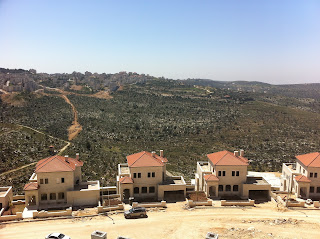As part of our process for interviewing subcontractors (a plumbing sub in this case), we visited the Diplomatic Subdivision today. It's a residential subdivision just on the outskirts of Ramallah designated for members of the Palestinian Authority or people associated with the Palestinian Government, and the level of luxury evident in these houses made it easy to forget that the people this government is representing are living under military occupation.
Here are some photos from the trip:
(street view of the villas)
(looking downhill, with apartments at the end of the street)
(the views from the balcony of one of the villas - looking towards Ramallah)
(another balcony view - another new Master-Planned Community in the foreground)
(master bathroom inside the villa)
(master bathroom fixtures)
Development is everywhere you look. From what I've been able to gather, condominium regime laws were introduced in 1993 and really facilitated the exchange of apartment ownership, then the mortgage system began entering the West Bank (apparently brought in by Jordanian banks investing in the Occupied Territories around the year 2000), and the elements for a housing boom were in place.
The start of the second uprising (Intifada) delayed the start of the housing boom, but as soon as the political situation started stabilizing the supply of apartments / condos began to increase and demand is projected to be at 7,000 - 8,000 units a year at a minimum (other figures I've read are as high as 40,000 per year for the next decade).
A banker colleague of mine said he read in a study that there is close to one billion US dollars "under the mattress" in the West Bank. That's roughly one seventh of the cash available to all the banks in the West Bank, and it's starting to come out from under the mattresses. The people of Palestine generally have strong saving habits, and 35 years of pent up demand are finally finding some available supply to start satisfying them.
Mortgage financing is now available through Western finance vehicles, as well as through Islamic finance institutions, and the usual terms these days are 15% down payment and 20-year mortgage. There are even institutions like the Palestine Mortgage Housing Corp. that offer 10% down payment and 25- year financing.
As for land prices, the desirable areas have plots that are 1 dunum (roughly 1/4 acre) selling for $1M ... just the land, no improvements on it. That's on the high side, but the average is around $300k-$400k per dunum in Ramallah.
Here's another view of west Ramallah taken from the Diplomatic Subdivision. Note the expansion down into the valleys:
(view towards Al Tireh neighborhood. Note the street cuts and all the fill material dumped downhill)
(neighboring property development - again note the fill material dumping mentioned in earlier posts)
(our proposed road filled back in after waterline construction)
(our new temporary water meter)
Tomorrow the blacksmith comes out to work on the mobile office, adding windows, doors and locks. Now all we have to do is find a contractor and we can get started!










































